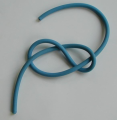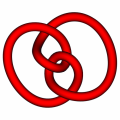Catching a knot!
 Let us take a string with free ends and try to knot it as we wish. We can make a simple knot, or a knot like those depicted in Milan in the central mosaic of the Galleria, or a running knot, or any other knot suggested by our imagination or our expertise of sailors, taylors, etc.
Let us take a string with free ends and try to knot it as we wish. We can make a simple knot, or a knot like those depicted in Milan in the central mosaic of the Galleria, or a running knot, or any other knot suggested by our imagination or our expertise of sailors, taylors, etc.
 If we do not join the free ends of the string, it is always possible to unknot it with a little bit of patience - even if we tied it very tightly, which is not very convenient in this case! We just need to let one of the loose ends go back following the knot.
If we do not join the free ends of the string, it is always possible to unknot it with a little bit of patience - even if we tied it very tightly, which is not very convenient in this case! We just need to let one of the loose ends go back following the knot.
After making any knot (or even after making nothing), let us try to join in some way the ends of the string by glueing them or by attaching a magnet to each of them and, after that, letting the two ends come together - it would be desirable not to make a new knot for this operation so that the original knot and the new "technical" knot will not be confused. In this way, we fix the knot "once and for all": for example, if you tie the string of a simple knot, by joining the ends , you will find the trefoil knot. We can lay it on a table in various ways which are different from that in the picture, but it will always be the trefoil if you do not cut the string.
 If, on the contrary, we knot a string and get one of the knots like those in the central octagon in the Galleria, in Milan, we find a knot which is called the “figure eight Knot” after tying the two ends of the string.
If, on the contrary, we knot a string and get one of the knots like those in the central octagon in the Galleria, in Milan, we find a knot which is called the “figure eight Knot” after tying the two ends of the string.
If, finally, we don’t knot a string at all, we will get a more or less circular knot after tying the two ends of the string: it is the unknot.
Now, let us try to manipulate these knots without pulling away the two joined ends. If we move them, "knotting" them more and more, we will realize the following:
- it is not possible to obtain the trefoil from the unknot and the unknot from the trefoil;
- it is not possible to obtain the trefoil from the figure eight knot and vice versa;
- it is possible to make any "groove" to the unknot and deform it back to the circle without cutting the string, which is not possible for the "real" knots;
- it is possible to obtain the unknot from the running knot and viceversa, in fact the running knot is the unknot!
The list might go on ......
If we tie a string and join the two ends of it, we "catch" in some way the real essence of a knot. Once we join the two ends, it does not matter what kind of manipulations we make provided we do not cut the string: the knot will always be the initial one.
 Now, you may try to reproduce the various knots on the poster A knotty issue from the exhibition matemilano. For this purpose, it is useful not to get confused by the under/over specifications at the various crossings on the two branches of the string. If you exchange one of them, the knot you will obtain may be completely different! Some diagrams may seem to be different at first sight; however they represent the same knot. For instance, among the diagrams on the poster there are three of them which represent the trefoil (this is the first, this is the second and this is the third). Three other knots represent the figure eight knot (this is first, this is the second and this is the third), e and finaly other three, besides the circle, which represent the unknot (this is the first, this is the second one and this is the third one).
Now, you may try to reproduce the various knots on the poster A knotty issue from the exhibition matemilano. For this purpose, it is useful not to get confused by the under/over specifications at the various crossings on the two branches of the string. If you exchange one of them, the knot you will obtain may be completely different! Some diagrams may seem to be different at first sight; however they represent the same knot. For instance, among the diagrams on the poster there are three of them which represent the trefoil (this is the first, this is the second and this is the third). Three other knots represent the figure eight knot (this is first, this is the second and this is the third), e and finaly other three, besides the circle, which represent the unknot (this is the first, this is the second one and this is the third one).
On the contrary, some diagrams, which may look different at first sight, represent different knots. For instance, three among these pictures have the same "shadow", but they represent the figure eight knot, the trefoil and the unknot respectively.
 As soon as the knot becomes more complicated, it is not easy at all to understand "before one's very eyes" if two knots are the same or not, and if a knot is the unknot or a real knot. You might have tried to disentangle a ball of wool fallen on the floor. If you imagine to join the ends of the ball, you may have an idea of how difficult it is to decide whether the knot is real or not.
As soon as the knot becomes more complicated, it is not easy at all to understand "before one's very eyes" if two knots are the same or not, and if a knot is the unknot or a real knot. You might have tried to disentangle a ball of wool fallen on the floor. If you imagine to join the ends of the ball, you may have an idea of how difficult it is to decide whether the knot is real or not.
Actually, it is even more complicated than what you might think. Not only is it difficult to realize "before one's very eyes" whether two knots are the same or not, but nobody has hitherto found an algorithm that can solve this problem in general!. In other words, the classification of knots is still an open problem in Mathematics.